
B.C. OUTDOOR ODYSSEY
"Catch & Release of large Fish"
with Barry M. Thornton
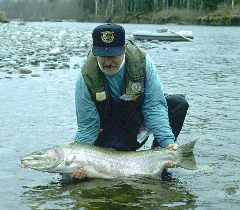
There is no doubt that the "Catch & Release" fishing phenomenon has
become the angling norm of the 90's! It is a philosophy which is doing much to enhance the
resource and provide added fishing pleasure for many anglers.
There has been a strong trend for the past two decades in the practice of
'catch-and-release' when angling for steelhead.
In fact many steelheader hold this classic trophy trout in deep reverence. Regulations
have followed this angling attitude to preserve the limited numbers of steelhead and as
well, the angler's opportunity to angle. This latter point is one for which I have been a
strong proponent for many years; the preservation of our right to angle.
It is interesting to note that approximately 80% of all steelhead beached in British
Columbia are now released. Well over 90% of those released do survive according to
extensive Pacific Northwest 'catch & release' studies!
It was in the late 70's that killed and released steelhead became equal in the angler's
catch. Since then, and, even with the introduction of hatchery steelhead in the 80's,
steelheaders continue to release many more steelhead than they kill, promoting "Catch
& Release" angling.
But, what about saltwater salmon? We all know how difficult it is to release a 60cm
chinook. It is just undersize but, still large and powerful.
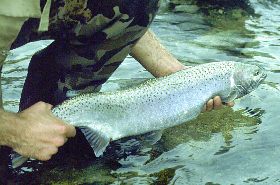 In a
conversation with Terry Gjernes, South Coast Coordinator for Recreational Fisheries, he
told me that a saltwater salmon catch and release study by Washington State supported his
DFO studies which he had done in recent years in British Columbia waters. Washington State
showed a 93% survival for coho and a 90% survival
for chinook in a catch and release fishery.
Terry did state that, "Handling doesn't make a difference, within reason. It is hook
injury which seems to determine mortality, particularly haemorrhaging through the gill
arches." In a
conversation with Terry Gjernes, South Coast Coordinator for Recreational Fisheries, he
told me that a saltwater salmon catch and release study by Washington State supported his
DFO studies which he had done in recent years in British Columbia waters. Washington State
showed a 93% survival for coho and a 90% survival
for chinook in a catch and release fishery.
Terry did state that, "Handling doesn't make a difference, within reason. It is hook
injury which seems to determine mortality, particularly haemorrhaging through the gill
arches."
Terry's study, by the Department of Fisheries & Oceans, DFO, is introduced in the
video, "RELEASE 'EM RIGHT," produced by the Recreational Fisheries Division. The
13 minute video features Ted Peck and Terry Gjernes in Strait of Georgia waters, as they conducted
the formal study of sports caught salmon on salmon caught with traditional sports gear.
All salmon caught were released after observation and holding, following 24 hours in a
saltwater aquarium.
The results presented in the video are quite interesting and should have long range
management implications for salmon sports fishing in British Columbia.
Salmon in different size categories were caught using a wide variety of traditional
sporting gear and handled in normal sport boat situations. The following chart, taken from
the video, shows the results;
| Size |
|
Species |
Survival% |
Mortality% |
| Less than 12 inches |
|
Coho |
85% |
15% |
|
Barbed hooks |
Chinook |
60% |
40% |
|
Barbless |
|
80% |
20% |
| From 14 to 18 inches |
|
Coho |
90% |
10% |
|
|
Chinook |
approx.90% |
10-12% |
| Over 18 inches |
|
Coho |
90-95% |
5-10% |
|
|
Chinook |
90% |
10% |
I have long known that released steelhead survival is very high
providing the fish is released in a careful manner. But, until this DFO publication, I was
unaware that the salmon survival rate in saltwater was equal or even greater than that for
released steelhead.
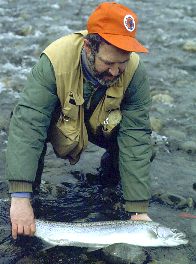 Now that our
winter steelheading season is once again upon us it is a good time to revisit the question
of how to best release these trophy fish. While speaking to various fishing groups in B.C.
and Washington State this past fall I was taken with the variety of methods used by
anglers when they release big fish like steelhead. There was no doubt in my mind that each
had the welfare of the fish uppermost in their concern but many were contradictory in
their various methods. The most common contradiction came over the use of gloves to hold
the fish secure so that the hook could be removed. Some were adamant that gloves were
necessary while others claimed that gloves absorbed the mucus where they touched the fish
and resulted in the removal of this protective slime thus allowing fungal infection and
freshwater parasites to infect the fish. I discussed this matter with Craig Wightman,
Senior Fisheries Biologist. He stated quite emphatically that, Now that our
winter steelheading season is once again upon us it is a good time to revisit the question
of how to best release these trophy fish. While speaking to various fishing groups in B.C.
and Washington State this past fall I was taken with the variety of methods used by
anglers when they release big fish like steelhead. There was no doubt in my mind that each
had the welfare of the fish uppermost in their concern but many were contradictory in
their various methods. The most common contradiction came over the use of gloves to hold
the fish secure so that the hook could be removed. Some were adamant that gloves were
necessary while others claimed that gloves absorbed the mucus where they touched the fish
and resulted in the removal of this protective slime thus allowing fungal infection and
freshwater parasites to infect the fish. I discussed this matter with Craig Wightman,
Senior Fisheries Biologist. He stated quite emphatically that,
"Wool gloves are not in the fishes best interest because of the potential loss of
mucus." He also felt that gloves were likely to provide serious disease transfer
between watershed by our mobile steelheaders who regularly fish more than one stream.
Throughout my discussion with anglers at these meetings the only common thread was one
of not handling the fish. Many felt that in this way the angler was certain of not
knocking off scales or wiping off the mucus. Studies I have read about these two fish body
coverings, scales and mucus, indicate that the mucus is the most important. There is an
indication that salmon can loose many scales and still survive with a healthy life. But,
should they loose a concentrated area of their slimy mucus they will inevitably die from
infections.
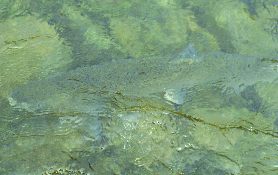 We know from
many studies that most steelhead are strong fish capable of a full recovery in a matter of
twenty-four hours after capture and release by anglers. The statistical numbers vary
between an 85% and 95% recovery but, they are dependent upon a number of factors which
include; how long the fish has been played; the water temperature; the supply of oxygen;
the physical handling which has occurred; and, the actual injury caused by the hook. We know from
many studies that most steelhead are strong fish capable of a full recovery in a matter of
twenty-four hours after capture and release by anglers. The statistical numbers vary
between an 85% and 95% recovery but, they are dependent upon a number of factors which
include; how long the fish has been played; the water temperature; the supply of oxygen;
the physical handling which has occurred; and, the actual injury caused by the hook.
I hold some reverence for this majestic anadromous rainbow trout for I believe that
they are the key indicator, the barometer of the health of our streams. I do believe that
they should always be treated with respect and dignity.
In their brochure, "Releasing Fish the Gentle Way", the Fisheries Branch has
four excellent recommendation which I would refer to all anglers.
[1] Play and release fish as rapidly as possible.
[2] Keep the fish in the water as much as possible.
[3] Be quick but gentle when you remove the hook.
[4] If you must handle the fish, do so with your bare, wet hands.
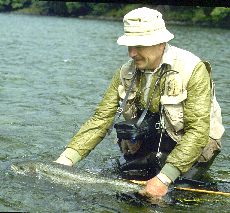 To these I would
add one additional item. Do not use factory barbless hooks because they are too needle
sharp and will penetrate too deeply. Instead, use a pair of pliers to crimp back the barb
on regular hooks. Finally, because steelhead live in a physical support medium which
protects their internal organs, never lift them out of the water except with the
recommended cradle method. With this method use both hands under the fish to hold it
upright should you need to take it out of To these I would
add one additional item. Do not use factory barbless hooks because they are too needle
sharp and will penetrate too deeply. Instead, use a pair of pliers to crimp back the barb
on regular hooks. Finally, because steelhead live in a physical support medium which
protects their internal organs, never lift them out of the water except with the
recommended cradle method. With this method use both hands under the fish to hold it
upright should you need to take it out of
water.
We have long known that small trout have a high survival rate (90%+) if they are
released carefully. Now that recent studies have shown that large fish like salmon and
steelhead also have a large survival rate I am certain that the 'catch & release'
angler attitude will continue as the future norm.
© Copyright Barry M. Thornton
Barry M. Thornton
| 




 In a
conversation with Terry Gjernes, South Coast Coordinator for Recreational Fisheries, he
told me that a saltwater salmon catch and release study by Washington State supported his
DFO studies which he had done in recent years in British Columbia waters. Washington State
showed a 93% survival for
In a
conversation with Terry Gjernes, South Coast Coordinator for Recreational Fisheries, he
told me that a saltwater salmon catch and release study by Washington State supported his
DFO studies which he had done in recent years in British Columbia waters. Washington State
showed a 93% survival for  Now that our
winter steelheading season is once again upon us it is a good time to revisit the question
of how to best release these trophy fish. While speaking to various fishing groups in B.C.
and Washington State this past fall I was taken with the variety of methods used by
anglers when they release big fish like steelhead. There was no doubt in my mind that each
had the welfare of the fish uppermost in their concern but many were contradictory in
their various methods. The most common contradiction came over the use of gloves to hold
the fish secure so that the hook could be removed. Some were adamant that gloves were
necessary while others claimed that gloves absorbed the mucus where they touched the fish
and resulted in the removal of this protective slime thus allowing fungal infection and
freshwater parasites to infect the fish. I discussed this matter with Craig Wightman,
Senior Fisheries Biologist. He stated quite emphatically that,
Now that our
winter steelheading season is once again upon us it is a good time to revisit the question
of how to best release these trophy fish. While speaking to various fishing groups in B.C.
and Washington State this past fall I was taken with the variety of methods used by
anglers when they release big fish like steelhead. There was no doubt in my mind that each
had the welfare of the fish uppermost in their concern but many were contradictory in
their various methods. The most common contradiction came over the use of gloves to hold
the fish secure so that the hook could be removed. Some were adamant that gloves were
necessary while others claimed that gloves absorbed the mucus where they touched the fish
and resulted in the removal of this protective slime thus allowing fungal infection and
freshwater parasites to infect the fish. I discussed this matter with Craig Wightman,
Senior Fisheries Biologist. He stated quite emphatically that,  We know from
many studies that most steelhead are strong fish capable of a full recovery in a matter of
twenty-four hours after capture and release by anglers. The statistical numbers vary
between an 85% and 95% recovery but, they are dependent upon a number of factors which
include; how long the fish has been played; the water temperature; the supply of oxygen;
the physical handling which has occurred; and, the actual injury caused by the hook.
We know from
many studies that most steelhead are strong fish capable of a full recovery in a matter of
twenty-four hours after capture and release by anglers. The statistical numbers vary
between an 85% and 95% recovery but, they are dependent upon a number of factors which
include; how long the fish has been played; the water temperature; the supply of oxygen;
the physical handling which has occurred; and, the actual injury caused by the hook. To these I would
add one additional item. Do not use factory barbless hooks because they are too needle
sharp and will penetrate too deeply. Instead, use a pair of pliers to crimp back the barb
on regular hooks. Finally, because steelhead live in a physical support medium which
protects their internal organs, never lift them out of the water except with the
recommended cradle method. With this method use both hands under the fish to hold it
upright should you need to take it out of
To these I would
add one additional item. Do not use factory barbless hooks because they are too needle
sharp and will penetrate too deeply. Instead, use a pair of pliers to crimp back the barb
on regular hooks. Finally, because steelhead live in a physical support medium which
protects their internal organs, never lift them out of the water except with the
recommended cradle method. With this method use both hands under the fish to hold it
upright should you need to take it out of